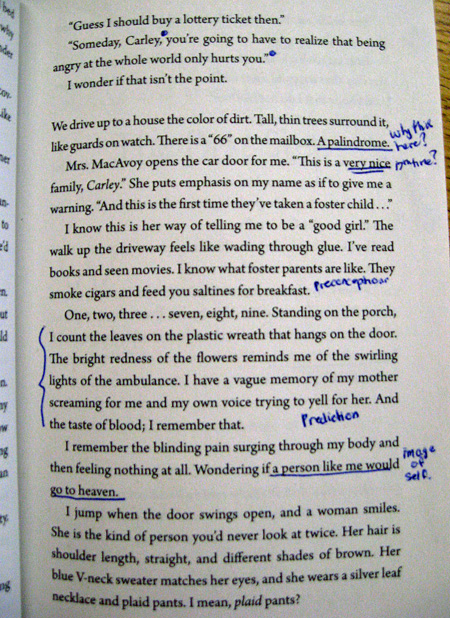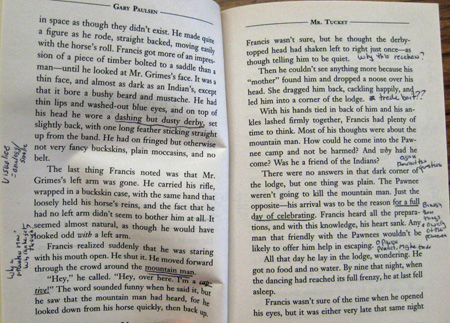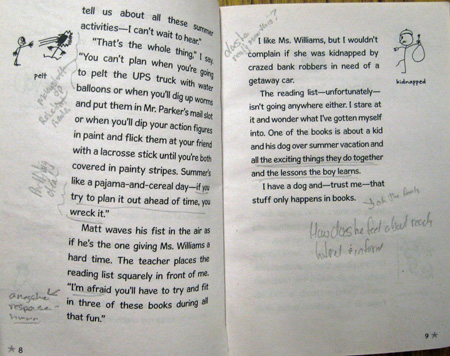Close reading is a challenge for many of us. The concept may not be, but inviting students to enjoy and be active in close reading is...well...interesting.
Douglas Fisher and Nancy Frey's Teaching Edge presentation at the 2013 IRA Convention affirmed the power of annotating. However, the act of annotating—the act of close reading—is often personal to the reader. How we model or portray our close reading for developing readers can be perceived as communicating the “right way to read,” which may stunt a reader's confidence. Showing students and giving them ideas on how to think, rather than what to think, requires a layer of scaffolding and confidence-building before students can accept the practice of close reading for their own, beyond a mini-lesson.
I’ve always thought that one of the most attractive books is a “gently loved” book, one covered with highlights, annotations, circles, and underlines. Consequently, I mark texts into oblivion. One for the Murphy's, Counting by 7's, My Life As A Book, and Elijah of Buxton are among my most pillaged—excuse me, gently loved books. Marking up the text allowed me to reflect, analyze writing, and thinking through strategic reading (i.e. reciprocal teaching strategies). My theory is: if students can see what how I am reading, they will be more encouraged to mimic my close reading. For many struggling readers and curious readers, the greatest blessing benefitting their reading is found in books I have read...and annotated.
I leave these texts in the classroom library for readers. My fifth and sixth grade readers love the “thinking” found within the margins of gently loved books. They are attracted to these books because they feel comprehension is more accessible. One reader, while reading One for the Murphy's wrote down two phrases from the text and told everyone how and why they were important lines, something new to this 11-year-old reader. Upon conferring with the student, I realized that she borrowed the phrases I had already underlined, as her own. When asking her why the two lines were important, she identified the implicit humor in one line and “everlasting” idea in the second line. The scaffold worked. She now looks for phrases in her own reading.
The already underlined phrases (and other annotations) presented a scaffold in two ways: 1) They are training the reader to look for subtle nuances and author's style within the text that influence meaning, theme, and overall comprehension (a.k.a. close reading); and 2) while modeling close reading in a mini-lesson exposes the concept, for some learners, seeing the thinking, the physical action of close reading within the text, is believing! Having the chance to look at someone's physical writing in margins, gives the maturing readers and chance to ponder how and why another reader arrived at a prediction, question, or clarification, invites intrigue in act of reading and reading comprehension. Some students just need that gentle scaffold, of borrowing someone else's work, to give them a jolt of confidence that inspires them to take “thinking” risks during their independent reading.




Portraying our reading lives helps students develop their reading lives. Annotating text and leaving maturing readers the blue prints is one more way to help maturing readers, not only enjoy reading, but find the treasures author's leave for discovery.
 Justin Stygles (@JustinStygles) is a Grade 5/6 ELA/Humanities teacher at Guy E. Rowe School in Norway, Maine, justin.vocabularyteacher@yahoo.com.
Justin Stygles (@JustinStygles) is a Grade 5/6 ELA/Humanities teacher at Guy E. Rowe School in Norway, Maine, justin.vocabularyteacher@yahoo.com.
Teaching in ACTion is a series from the Advisory Committee of Teachers (ACT), an International Reading Association committee comprised of exemplary reading and literacy teachers from around the world. Educators who best exemplify the mission of IRA are chosen from a pool of applicants to serve a three-year term. Among other responsibilities, the main charge of ACT is to be the conduit between IRA’s members and the board of directors.
ACT invites member to engage in the conversation by sending responses to us. ACT’s goal is to get a feel for how members feel about current hot topics, so that we may better serve members by sharing their concerns with the board of directors.